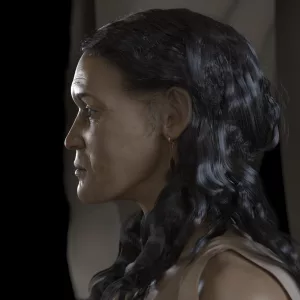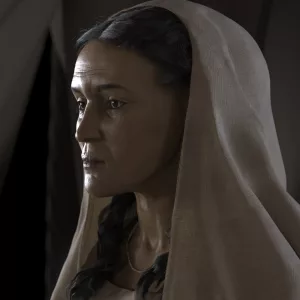ALULA, Saudi Arabia: A team of archaeologists, academics and specialists in the fields of forensic science and model-making has completed the first known digital and physical reconstruction of a Nabataean woman discovered at Hegra, a UNESCO World Heritage Site that was once a vibrant city for this North Arabian kingdom which dominated the historic Incense Road.
The Nabataean woman is known as Hinat, and is thought to have been a prominent woman who died around the first century BCE and lay for over 2,000 years in a Hegra tomb.


The reconstruction is now being displayed at the Hegra Welcome Centre in AlUla.
Hinat’s return comes in the 15th year since Hegra was inscribed as the first UNESCO World Heritage Site in Saudi Arabia. UNESCO’s citation at the time said the site “bears outstanding witness to important cultural exchanges in architecture, decoration, language use and the caravan trade”.
Thanks to the Hinat reconstruction, Hegra continues to bear witness to important cultural moments.
The Royal Commission for AlUla (RCU) expects many more important advances in coming years as the painstaking work of archaeology across the AlUla area diligently uncovers the secrets of the past.
AlUla has at its heart an oasis and valley that has hosted successive communities and civilisations from its earliest occupants to its residents today. An important hub on epic routes of trade — including in valuable incense, spices and other luxury commodities — it has vestiges from virtually every major period from prehistory to the present day including the site of Hegra, a significant city of the Nabataean Kingdom.
By the first century BCE, Hegra under the Nabataeans had eclipsed nearby Dadan as the key stopping point on trade routes linking southern Arabia to Egypt and the Mediterranean.
The Mada’in Salih Archaeological Project began its archaeological work at the Hegra site in 2002.
Hinat, as she is affectionately known by the archaeologists who discovered her, was excavated from one of Hegra’s monumental tombs in 2008. Excavations of the tomb revealed around 80 individuals interred there, and the pathology suggests at least some were blood relations. The majority were disarticulated but Hinat’s skeleton was near complete.
The inscription on the tomb reads: “This is the tomb that Hinat daughter of Wahbu made for herself and her children and descendants forever”.
This inscription emphasises the importance of women in Nabataean Hegra society, who owned property and had the financial means to commission their own tombs.
Mada’in Salih Archaeological Project Co-Director Laïla Nehmé and project anthropologist Nathalie Delhopital led the selection of an appropriate skull, with sufficient preservation to ensure adequate information for successful reconstruction.
A one-day scientific roundtable event, drawing together leading experts on Hegra, the Nabataeans and the archaeology of AlUla, saw a lively discussion around the likely appearance of Hinat, her potential status in society, and what she may have worn.
This established the scientific boundaries and guidance for the accuracy and character of the reconstruction and resulted in the writing of a profile with reference imagery for clothing, hair and jewellery.
They were joined by a multidisciplinary production team, bringing together expertise in forensic anthropology and reconstruction, and physical model-making.
Dr Helen McGauran, Heritage Curatorial Expert at RCU, who led the RCU-facilitated initiative, said: “Through pioneering efforts such as this, which bring together professional rigour and careful artistic interpretation, we are able to deepen our understanding of the lives and culture of the Nabataeans — a civilisation that has gifted the world the extraordinary site of Hegra, and continues to be a source of knowledge and inspiration.”
Leila Chapman, Narrative Experience Expert at RCU, added: “The opportunity for our visitors to come face to face with a Nabataean woman at the actual site of Hegra — where she lived, and was honoured by her family — is hugely exciting. We are especially excited that AlUla’s people will see this recreation of their ancient ancestor.”
RCU-supported archaeological research and conservation teams continue to shed new light on the history of the region and lay the intellectual foundation of the Kingdoms Institute, a hub of archaeological knowledge being established at AlUla.

